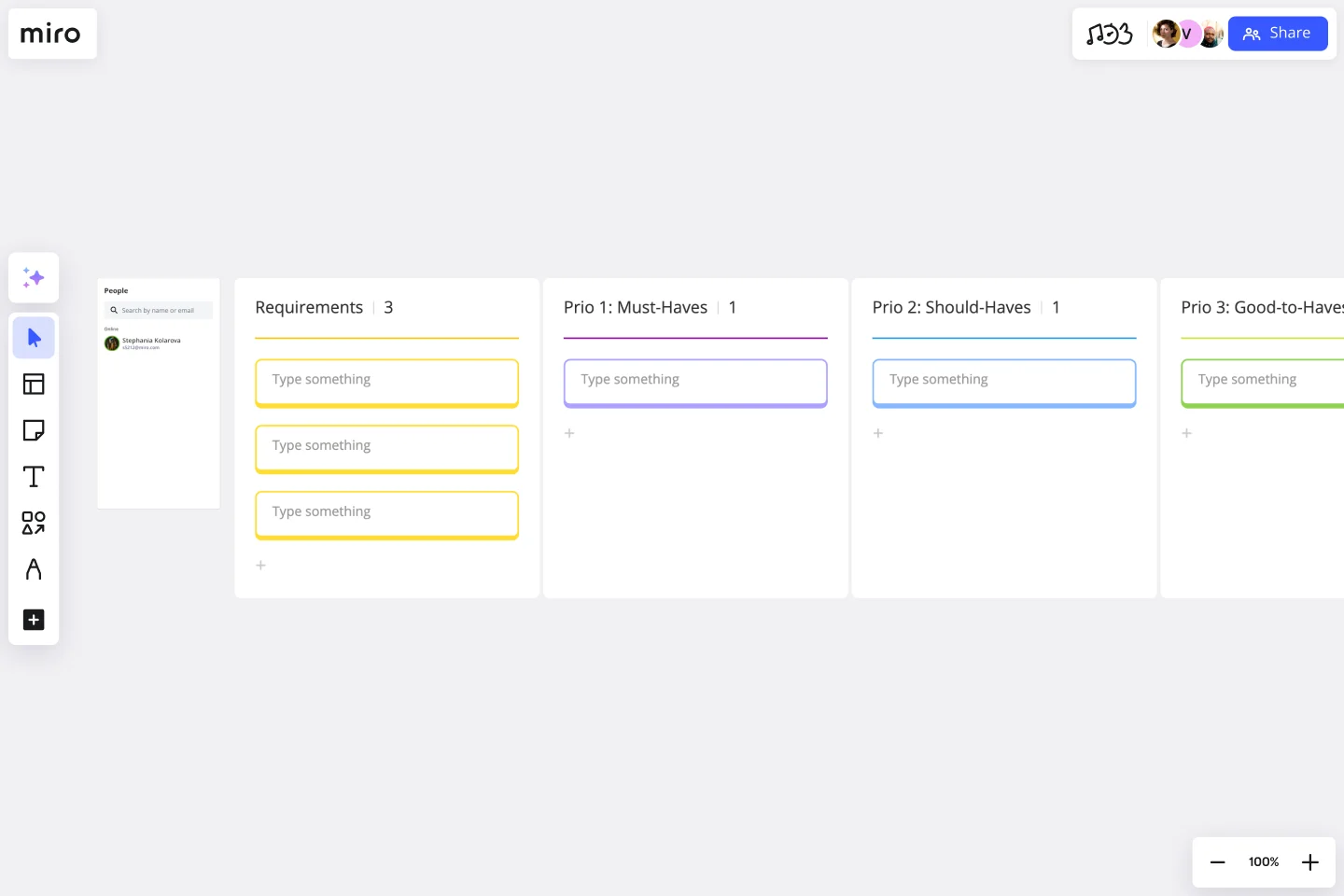Requirements Gathering Template
Streamline prioritization and allocate resources efficiently with the requirements gathering template.
About the Requirements Gathering Template
If you start a project without a clear vision, it's akin to sailing without a compass, directionless and uncertain. But, with the requirements gathering template, you can chart a well-defined course for your team from the outset. This effective tool helps align priorities and ensures your project stays on track for success.
The requirements gathering template allows teams to clearly define, categorize, and prioritize their project requirements. This template is divided into distinct fields to guide the project requirements process:
Requirements: This is the overarching section where the core needs of the project are detailed. It provides a high-level view of what the project aims to achieve.
Must-Haves: These are the non-negotiables. These elements are necessary for the project to be completed and successful. This section ensures that the primary objectives are always in focus.
Should-Haves: While not critical to the project's completion, these requirements could have a considerable impact on the project's success. They're not essentials, but their presence is highly beneficial.
Good-to-Haves: These are the "cherries on top." While they would be a useful addition to the project, they are not imperative. They can enhance the project but aren't pivotal to its success.
By filling out each field, teams ensure that all aspects of the project are considered and appropriately prioritized.
How to use the requirements gathering template in Miro
Add your project specifics: Open the template and then click on a specific field, and start adding your info. It's designed to be user-friendly.
Expand if needed: Should your project demand more specifics, effortlessly append more fields or frames with just one click.
Integrate artifacts: Whether they're diagrams, images, or other documents, easily drag and drop them onto the board for richer context.
Why should you use a requirements gathering template?
Clear prioritization: The template allows teams to visually distinguish between essential and optional requirements.
Focused approach: By clearly defining the must-haves, teams can allocate resources more effectively.
Flexibility: The distinction between should-haves and good-to-haves enables teams to adjust scope based on constraints like time or budget.
Comprehensive view: It provides a holistic snapshot of the project's needs and wants.
Enhanced collaboration: Encourages team-wide discussions to ensure all perspectives are considered while defining requirements.
Is the template adaptable for different project types?
Definitely! The requirements gathering template is adjustable, and you can tailor it for various projects by adding or deleting sections.
How do I share my template with my team?
Invite your team members to your board by sharing your board link or download the template as an image or PDF.
Can I add more sections to the template if needed?
The template is flexible, allowing you to add or remove sections based on the project's demands.
Get started with this template right now.
Product Vision & Differentiation Strategy Template
Works best for:
Product Management, Planning
The Product Vision & Differentiation Strategy Template assists product managers in crafting compelling product visions and differentiation strategies. By articulating product goals, unique value propositions, and competitive advantages, this template guides strategic planning and execution. With sections for defining target markets and assessing market dynamics, it enables product managers to create differentiated products that resonate with customers. This template serves as a roadmap for achieving market leadership and sustainable growth through product innovation.
Define A Winning Product Vision
Works best for:
Product Management, Planning
The Define A Winning Product Vision template assists product teams in articulating compelling visions for product development. By defining goals, target markets, and differentiation strategies, this template aligns teams around a shared vision for success. With sections for outlining product features, benefits, and value propositions, it communicates the essence of the product effectively. This template serves as a guiding light for product development efforts, inspiring creativity and focus as teams work towards bringing the product vision to life.
Product Development Roadmap Template
Works best for:
Product Management, Software Development
Product development roadmaps cover everything your team needs to achieve when delivering a product from concept to market launch. Your product development roadmap is also a team alignment tool that offers guidance and leadership to help your team focus on balancing product innovation and meeting your customer’s needs. Investing time in creating a roadmap focused on your product development phases helps your team communicate a vision to business leaders, designers, developers, project managers, marketers, and anyone else who influences meeting team goals.
The 4-Step Retrospective
Works best for:
Retrospectives, Agile Methodology, Meetings
The 4-Step Retrospective template offers a simple yet effective framework for conducting retrospectives. It provides steps for reflecting on what went well, what didn't go well, what could be improved, and action planning. This template enables teams to systematically review past iterations, identify areas for growth, and implement actionable improvements. By promoting a structured approach to reflection and improvement, the 4-Step Retrospective empowers teams to drive continuous learning and enhancement effectively.
Product Voice Design toolkit
Works best for:
Product Management, Planning
The Product Voice Design toolkit facilitates the development of consistent and impactful product messaging. By defining brand voice attributes, tone guidelines, and messaging principles, this toolkit ensures that product communication resonates with target audiences. With sections for crafting messaging frameworks, storytelling templates, and content guidelines, it empowers product teams to create compelling and cohesive product narratives. This toolkit serves as a valuable resource for enhancing product communication strategies and building strong brand identities.
Product Development Phases
The Product Development Phases template assists product teams in managing and tracking product development stages effectively. By defining key phases such as ideation, design, development, and launch, this template provides a structured framework for project planning and execution. With sections for setting milestones, allocating resources, and tracking progress, it enables teams to streamline development processes and drive projects to successful completion. This template serves as a roadmap for navigating the complexities of product development and ensuring timely delivery of high-quality products.
